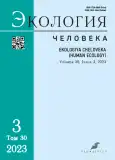Роль антропогенных дерматотоксикантов в формировании угревой болезни у подростков
- Авторы: Пильник Е.Н.1, Дерягина Л.Е.2, Рейнюк В.Л.1, Пятибрат А.О.3
-
Учреждения:
- Научно-клинический центр токсикологии имени академика С.Н. Голикова
- Московский университет имени В.Я. Кикотя
- Санкт-Петербургский государственный педиатрический медицинский университет
- Выпуск: Том 30, № 3 (2023)
- Страницы: 199-211
- Раздел: ОРИГИНАЛЬНЫЕ ИССЛЕДОВАНИЯ
- URL: https://bakhtiniada.ru/1728-0869/article/view/131795
- DOI: https://doi.org/10.17816/humeco112524
- ID: 131795
Цитировать
Полный текст
Аннотация
Обоснование. На фоне неснижающихся темпов урбанизации негативное влияние антропогенных токсических веществ на здоровье человека увеличивается с каждым годом.
Цель. Определить роль токсических металлов в формировании угревой болезни.
Материал и методы. В исследовании методом поперечных срезов обследовано 595 детей различных районов Подмосковья, из них 301 подросток страдал угревой болезнью, 294 практически здоровых детей составили контрольную группу. В работе использовали также спектрометрические, цитогенетические, биохимические и иммунологические методы. Оценивали содержание эссенциальных и токсических микроэлементов в пробах волос подростков. Проводили микроядерный тест в клетках буккального эпителия. Оценивали уровень тестостерона и иммунорегуляторный индекс. Прогностические алгоритмы строили с помощью дискриминантного анализа.
Результаты. Статистически значимое (р <0,01) повышение концентрации свинца определялось у 23% подростков, страдающих угревой болезнью, кадмия — у 19% и ртути — у 20%, в то время как в контрольной группе это были 10, 5 и 8% соответственно. Среди больных угревой болезнью статистически значимое (р <0,01) снижение концентрации селена определялось у 22% подростков, цинка — у 16% подростков, в то время как в контрольной группе — только у 6%. По результатам микроядерного теста признаки генетической нестабильности определялись у 42% подростков, страдающих угревой болезнью, и у 19% — в контрольной группе. Выявлена положительная корреляционная взаимосвязь генотоксических нарушений с концентрацией свинца и ртути в пробах волос подростков.
Заключение. Подростки с преимущественно интоксикационной этиологией угревой болезни характеризовались низкой концентрацией селена и цинка, высокой — ртути и свинца в пробах волос, а также увеличением количества микроядер в буккальном эпителии. Для подростков с преимущественно гормональной этиологией угревой болезни характерны повышение уровня тестостерона и снижение иммунорегуляторного индекса. Построенные прогностические алгоритмы позволяют дифференцировать угревую болезнь у подростков по этиологическому фактору.
Полный текст
Открыть статью на сайте журналаОб авторах
Елена Николаевна Пильник
Научно-клинический центр токсикологии имени академика С.Н. Голикова
Автор, ответственный за переписку.
Email: pilnik.76@mail.ru
ORCID iD: 0000-0002-0489-8132
SPIN-код: 3821-7106
ResearcherId: 1155658
аспирант
Россия, Санкт-ПетербургЛариса Евгеньевна Дерягина
Московский университет имени В.Я. Кикотя
Email: lderyagina@mail.ru
ORCID iD: 0000-0001-5522-5950
SPIN-код: 6606-6628
Scopus Author ID: 6506233281
ResearcherId: N-5766-2015
д.м.н., профессор
Россия, МоскваВладимир Леонидович Рейнюк
Научно-клинический центр токсикологии имени академика С.Н. Голикова
Email: institute@toxicology.ru
ORCID iD: 0000-0002-4472-6546
SPIN-код: 5828-0337
Scopus Author ID: 9844286100
д.м.н., доцент
Россия, Санкт-ПетербургАлександр Олегович Пятибрат
Санкт-Петербургский государственный педиатрический медицинский университет
Email: a5brat@yandex.ru
ORCID iD: 0000-0001-6285-1132
SPIN-код: 9812-4780
Scopus Author ID: 57203367911
ResearcherId: AGS-3308-2022
д.м.н., доцент
Россия, Санкт-ПетербургСписок литературы
- Вертинский А.П. Проблемы загрязнения окружающей природной среды Российской Федерации тяжелыми металлами // Инновации и инвестиции. 2020. № 1. С. 232–237.
- Черняк Ю.И., Меринова А.П. Полиморфизм CYP3A генов и хроническая ртутная интоксикация // Бюллетень экспериментальной биологии и медицины. 2019. Т. 168, № 10. С. 479–483.
- Fu Z., Xi S. The effects of heavy metals on human metabolism // Toxicol Mech Methods. 2020. Vol. 30, N 3. P. 167–176. doi: 10.1080/15376516.2019.1701594
- Матушевская Е.В., Владимирова Е.В., Свирщевская Е.В. Атопический дерматит и роль цинка в поддержании барьерных свойств кожи // Клиническая дерматология и венерология. 2020. Т. 19, № 3. С. 297–304. doi: 10.17116/klinderma202019031297
- Мельнов С.Б. Молекулярно-генетические аспекты экологического неблагополучия (возможности проточной цитофлуориметрии). Минск : Белорусский комитет «Дзецi Чарнобыля», 2004. 294 с.
- Поспелова С.В., Горовиц Э.С., Кривцов А.В., Долгих О.В. Изучение защитных антибактериальных механизмов у детей, проживающих в условиях воздействия выбросов предприятия черной металлургии // Лабораторная служба. 2021. Т. 10, № 2. С. 22–27.
- Малышева Е.В., Фомичев А.В., Сосюкин А.Е., и др. Современные представления и перспективы применения энтеросорбентов в профилактике и лечении неблагоприятного воздействия соединений тяжелых металлов // Вестник Российской Военно-медицинской академии. 2020. № S3. С. 137.
- Литвинцев Б.С., Фомичев А.В., Великова В.Д., Малышева Е.В. Неврологические последствия воздействия соединений ртути у пациентки Х., 60 лет // Вестник Российской Военно-медицинской академии. 2020. № S3. С. 136–137.
- Скугорева С.Г., Ашихмина Т.Я., Фокина А.И., Лялина Е.И. Химические основы токсического действия тяжёлых металлов (обзор) // Теоретическая и прикладная экология. 2016. № 1. С. 4–13.
- Balali-Mood M., Naseri K., Tahergorabi Z., et al. Toxic mechanisms of five heavy metals: mercury, lead, chromium, cadmium, and arsenic // Front Pharmacol. 2021. Vol. 12. P. 643972. doi: 10.3389/fphar.2021.643972
- Луковникова Л.В., Фомичев А.В., Иваненко Н.Б., и др. Система биомониторинга химических загрязнений и оценка влияний токсикантов на здоровье человека: проблемы и пути их решения // Вестник образования и развития науки Российской академии естественных наук. 2020. № 4. С. 111–124. doi: 10.26163/RAEN.2020.97.10.016
- Скальный А.В., Лакарова Е.В., Кузнецов В.В., Скальная М.Г. Аналитические методы в биоэлементологии. Санкт-Петербург : Издательство «Наука», 2009. 264 с.
- Определение вредных веществ в биологических средах : сборник методических указаний. Москва : Федеральный центр гигиены и эпидемиологии Роспотребнадзора, 2008. 183 с.
- Сетко А.Г., Сетко Н.П., Макарова Т.М., Сетко И.М. Особенности адаптированности детей к факторам среды обитания и критерии их оценки // Гигиена и санитария. 2005. № 6. С. 57.
- Al Osman M., Yang F., Massey I.Y. Exposure routes and health effects of heavy metals on children // Biometals. 2019. Vol. 32, N 4. P. 563–573. doi: 10.1007/s10534-019-00193-5
- Bodnar M., Konieczka P., Namiesnik J. The properties, functions, and use of selenium compounds in living organisms // J Environ Sci Health C Environ Carcinog Ecotoxicol Rev. 2012. Vol. 30, N 3. P. 225–252. doi: 10.1080/10590501.2012.705164
- Овсянникова А.И. Состояние системы иммунитета при экспериментальной хронической свинцовой интоксикации. Влияние селенита натрия : дис. ... канд. мед. наук. Владикавказ, 2013.
- Тутельян В.А., Мазо В.К., Ширина Л.И. Значение селена в полноценном питании человека // Гинекология. 2002. Т. 4, № 2. С. 88–90.
Дополнительные файлы







